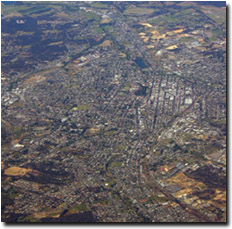Indicators of Urban Salinity
What is Urban Salinity? | Buildings & Structures | Road Assets | Vegetation & Earth
| Introduction Urban salinity is an emerging problem across Victoria, causing damage to many natural and built assets including buildings, bridges, pipelines, cemeteries, parks and gardens, lakes and waterways. Salinity also affects private homes and gardens. The Central Victorian city of Bendigo has been experiencing salinity problems since the 1980’s. As for many areas in Australia, it took time to realise that salinity was not only a problem in the rural areas, but also for the local urban community. Following a long-term salinity education program in Bendigo, an Infrastructure Benchmarking Project was developed in 2003 by Sinclair Knight Merz (SKM) (external link), Phil Dyson and Associates, the former Department of Primary Industries (DPI) and City of Greater Bendigo (external link) under the revised North Central Dryland Salinity Management Plan. This project aims to assist City of Greater Bendigo asset managers to identify, monitor and record asset condition in saline areas over time. |  Aerial view of part of Bendigo |
As part of the Benchmarking project, an "Indicators of Urban Salinity A Reference Guide for Asset Managers' was developed by SKM. The report attempts to cover a broad range of common symptoms or 'indicators' of urban salinity in Bendigo. While specifically applicable to the City of Greater Bendigo, it can be used to guide the identification of salinity and its impacts in other towns and cities. Material on this website has been derived from that report.
Care must be taken when attempting to identify damage resulting from salinity and shallow watertables, as other factors may also contribute. The Figures shown on this website should be used as a guide to the types of urban salinity symptoms that can occur. These indicators can be used to identify potential urban salinity issues and trigger further investigation, monitoring and management.
While using local examples of urban salinity, information on this website has also been derived from these Local Government Salinity Initiative publications:
Collings, A (2002) Indicators of Urban Salinity. NSW Department of Land and Water Conservation, Sydney, New South Wales. ISBN: 07347 5276 9.
Ryan, M. (2003) Introduction to Urban Salinity. NSW Department of Infrastructure, Planning and Natural Resources. Sydney, New South Wales. ISBN: 0 7347 5376 4.
The Infrastructure Benchmarking Project has built on the work of the Bendigo Urban Salinity Reference Group, which comprises representatives from the Department of Primary Industries, the City of Greater Bendigo and Phil Dyson & Associates. This group was formed in 2001 to raise awareness of urban salinity issues in Bendigo and to develop strategic responses to them.


